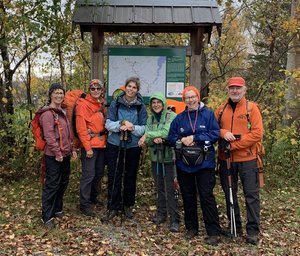Elaine Falconer helps Nova Scotians find their path
Elaine at Hart Peak, N.S.
Pictou County, N.S., is a nature-lover’s dream. It’s home to sandy beaches, winding rivers and many wooded trails. It’s also where Elaine Falconer, a retired Michelin safety specialist, has been leading guided hikes, offering snowshoeing courses and teaching field leadership for the last 30 years.
Deep roots
Growing up in the small community of River John enabled Elaine to form a strong connection with her surrounding environment. She says that for her, participating in outdoor activities is just a way of life. “I am passionate about anything that has to do with the outdoors: beach walking, hiking, biking, swimming, stand-up paddleboarding, cross-country skiing, snowshoeing and skating.”
Elaine shares this connection with her five grandchildren. She says, “I am very passionate about instilling a love of the outdoors in them.”
Hiking builds connections
Elaine believes that outdoor people are natural “sharers.” An extrovert, she loves hosting community-based activities as a way to bring people together. Hiking has grown her social circle exponentially. “My friends and I are very welcoming to newcomers who wish to participate in whatever we are doing, so our group keeps getting bigger and more diverse,” says Elaine.
Joining a hiking club can be a great way to find others with similar interests. “Be chatty and friendly; share your hiking, walking, biking or beach-walking experiences,” says Elaine. “Invite people on your adventures, the more the merrier! They will also share trails they know and invite you back.”
Consider others who may have different needs too. Elaine shares, “We have a gentleman from Visually Impaired Pictou County who regularly hikes with us. He was specific about how he needed to be guided and the rest is history. He participated in a three-day long hike with us, has joined Cape to Cape and serves on a committee.”
Winter hikes
The winter doesn’t slow Elaine down; she sees so much to appreciate about the colder season. “I love the freshness in the air, the beauty of the trees as their branches are hanging down from a fresh snowfall,” she says. “The wind chill can be -30C, but once you get into the woods and out of the wind, it is not that cold at all.”
Maguma Falls on Willard Kitchener Trail
For those who are new to winter trail walking, Elaine has a few pointers to help get you started. She advises waiting a couple of days after a storm until the snow gets packed down. Also important: wearing crampons or “ice grippers” on your boots. She recommends that you dress in layers, so you can remove and add as needed. Using trekking poles can help you stay balanced. She says, “Look online to understand how to set the poles to the proper height for you.” Finally, she recommends wearing sunscreen and lip balm.
Tips for new hikers
To ensure you have an enjoyable experience, here are Elaine’s tips if you are new to hiking:
Take a whistle, water and a snack.
Let someone know where you are going and when you should be back.
Start out slow and don’t be hard on yourself. Set the amount of time you want to walk/hike, and don’t worry about distance. If your goal is 20 minutes, walk/hike for 10 minutes and then turn around.
Visit the Hike Nova Scotia web page for its guided walk schedule and pick an easy one. Registration is generally required. Hiking groups are very interested in gaining new members and will try to accommodate specific needs if they are made known.
Tips for those who want to lead
For seasoned hikers who are thinking of becoming field instructors, here are some tips from Elaine:
Don’t plan a hike in isolation; involve group members and stakeholders.
Don’t plan a “perfect hike”; do a pre-hike with other group members.
The hike is not about you, but the participants.
Manage group dynamics and set a pace that keeps the group together; at least keep within eye or earshot of each other.
Create an atmosphere of team cohesiveness so it feels that everyone cares about everyone else.
When advertising your hike, be specific about distances, elevations, terrain, and so on, so that when potential participants read the details, they can choose the hike that’s right for them.
Once you understand how to lead a safe, quality hike, Elaine says, it becomes easier to be in the moment with the people who have joined your hike. “It is not always about speed. Hike in the front, hike in the middle, hike at the back of the group. Chat with your group to see how they’re doing.”
Find your path
No matter where you are in Nova Scotia, there’s always a hiking trail or a walking path nearby. There are many that are accessible, too. If you’re inspired by this blog post and want to deepen your involvement with the hiking community, be sure to check out Hike Nova Scotia, Cape to Cape, Take a Hike, Heartland Tour, Curvy Girls Hiking or the Melanated Aces. If you are a part of a hiking group or walking group that is not mentioned here, let us know in the comments below. Happy trails!













